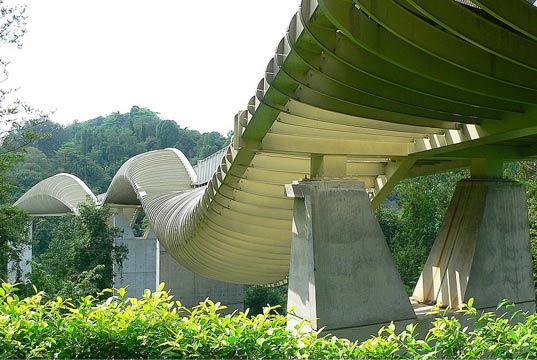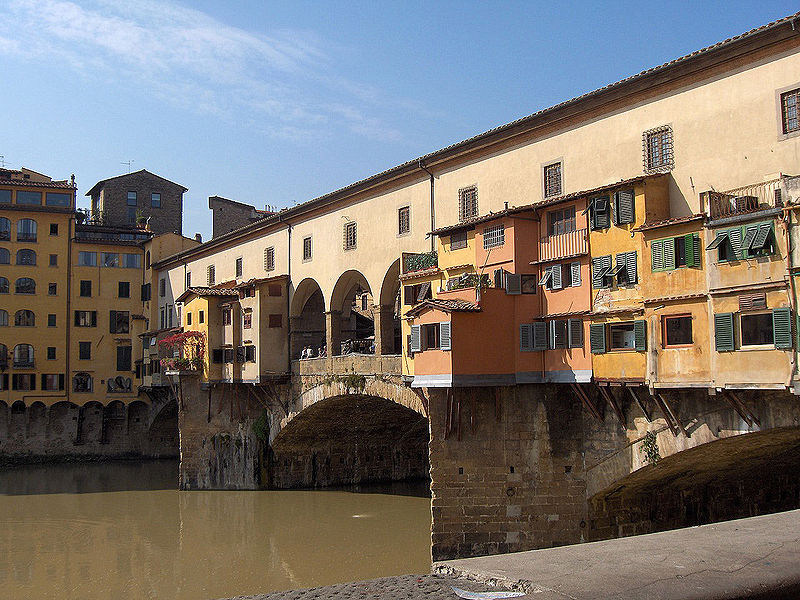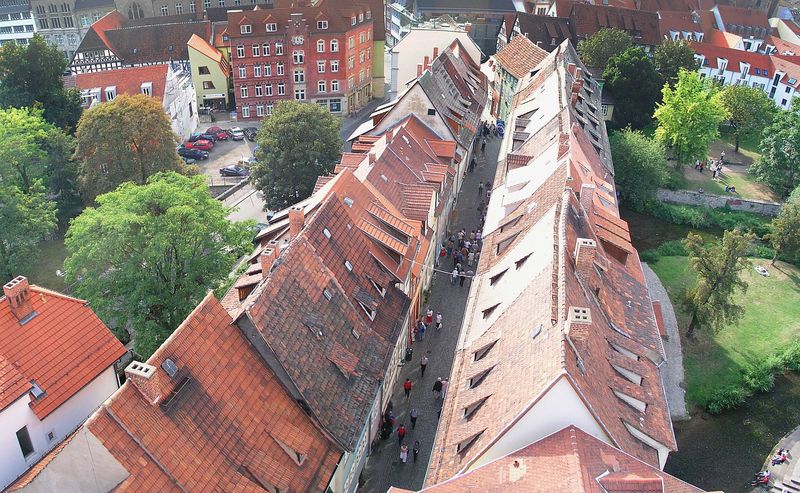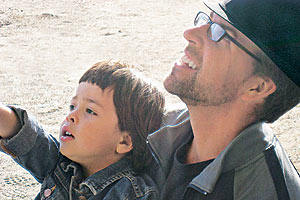Bridges are inherently romantic. Why?
They’re dramatic, of course: our hearts race as one sweeps into view; eyes fill with awe as we stand on a beach looking up at a span; walking across a bridge, we can see cities and harbors whole.
By definition, a bridge connects one place to another, and thus seems to promise transition and adventure. Time seems to stand still as we make the crossing, wondering what new world might greet us on the other side.
And in a time of rapid technological and social change, the bridge-as-metaphor holds special resonance. Bridges can seem to describe the collective digital flux of our lives, each one a kind of high-flying commons. Indeed, we as twenty-first-century individuals are the bridge — or so we might suppose — building ourselves as we go.
Here’s a peripatetic list of bridge designs that might point the way to a mobile, interdependent, open-source world.
1. The Pedestrian Bridges of Telok Blangay Hill Park (and other cool, sustainable footbridges)

Look, up in the sky! It’s a bird! It’s a plane! It’s…flying infrastructure!
“Telok Blangah is certainly breathtaking, ” reports Vietnam Real Estate Online, “but it also has the right kind of attitude when it comes to respecting nature. While some parks are constructed by chopping trees down to make room for open space and eliminating the animals that make their home there, Telok Blangah’s layout chose to preserve the natural landscape and instead build around it.”
This was accomplished through a web of high-flung, open-air, internationally renowned pedestrian bridges:

The Telok Blangah footbridges are part of a wave of environmentally sustainable bridge designs.
For example, the 470-meter Kurilpa footbridge in Brisbane, Australia features LED lighting system is powered by 84 integrated solar panels that are connected to the city’s power grid. As a result, the bridge can get power when needed or give power back to the grid when a surplus is generated.

Another example: The planned Copenhagen Harbor LM Project combines sustainable technologies like photovoltaic-sheathed skyscrapers and a wind turbine-studded skybridge with a commitment to mixed usage–the towers and bridge contain a public auditorium, offices, shops, skyways, and a terrace.

2. The Bay Bridge (the real one, and various imaginary)

The epic, ongoing reconstruction of the San Francisco Bay Bridge has involved deaths, crashes, sudden shut-downs, pitched rhetorical battles between advocates and engineers, and more.
The old bridge was strictly for cars, but bikes and cars will share the new one, and it will cross over Treasure Island, which is being redeveloped as a kind of intentional urban community. That’s real life.
But the Bay Bridge has also fired the imaginations of writers and architects.

In William Gibson’s 1994 science-fiction novel Virtual Light, the Bay Bridge is a small city of squatters and technological rebels. Here’s how City of Quartz author Mike Davis characterizes Virtual Light’s Bay Bridge:
Gibson proposes that, in a world where giant multinational is supreme, there are places that simply aren’t valuable to the world economy anymore–they don’t reproduce capital–and so those spaces are shunted aside. A completely globalized system, in Gibson’s view, would leak space–it would have internal reduncies–and one of those spaces, in Virtual Light, is the San Francisco Bay Bridge.
 Perhaps inspired by his vision, Bay Area architects Ronald Rael and Virginia San Fratello once called for turn the soon-to-be-dismantled portion of the Bay Bridge into a park (not unlike Manhattan’s Highline) and affordable intentional community. Unlike Gibson’s Bay Bridge, however, theirs would magnet for real estate investment, instead of a hole in the global economy. “This proposal seeks to repurpose abandoned and closed bridges as sites of potential for parks, cultural centers and housing,” the architects write in the project proposal. They continue:
Perhaps inspired by his vision, Bay Area architects Ronald Rael and Virginia San Fratello once called for turn the soon-to-be-dismantled portion of the Bay Bridge into a park (not unlike Manhattan’s Highline) and affordable intentional community. Unlike Gibson’s Bay Bridge, however, theirs would magnet for real estate investment, instead of a hole in the global economy. “This proposal seeks to repurpose abandoned and closed bridges as sites of potential for parks, cultural centers and housing,” the architects write in the project proposal. They continue:
The immense load capacity of rail bridges allows for the support of program beyond that of parks, suggesting the urbanization of bridges. While the current economic climate suggests a surplus of housing, the economic reality also suggests a push towards urbanization and often the “affordable” housing constructed in suburban environments, which encroaches on the rural, is not what is needed.
Instead, by using abandoned bridges in urban areas, we are creating opportunities for sustainable low-cost housing within the urban realm—creating the potential for creative speculation among housing developers by expounding upon the nascent potential of a layered housing-park-bridge typology.
3. The Ponte Vecchio (and the Krämerbrücke, and beyond)

Rael and San Fratello didn’t imagine their Bay Bridge proposal from scratch; the 1,000-year-old Ponte Vecchio in Florence, Italy anticipates their conception of the bridge as suspended mixed-use street.
Its first residents, I’m told, were medieval butchers, most of whom lived above their shops. Today, it’s a tourist trap where one can purchase jewels, art, and souvenirs.
The Ponte Vecchio isn’t unique in Europe: the Krämerbrücke in Germany, also a millennium old, holds up 32 houses.

The Ponte Vecchio and Krämerbrücke are both ancient, but they somehow evoke a future time, at least for me. With sea levels rising, could bridges become the twenty-first-century’s next gated communities?
In a piece for the current issue of The Urbanist, Laura Tam suggests that the Bay Area might embrace elevated and floating homes and infrastructure in response to climate change. This would entail putting buildings on stilts or boardwalks, or developing houseboat neighborhoods and floatable homes–also called amphibious homes, which (bonus!) have the California advantage of being earthquake proof.
Amphibious homes and infrastructure aren’t science fiction; they are already a reality in the Netherlands:
Whereas classic construction techniques in the Netherlands rely on underground concrete pilings to support structures in the spongy soil, an amphibious house comes with foam built into a hollow concrete basement. When the water rises or falls, the houses float to up to 18 feet above ground by sliding along two mooring poles at the front and rear of the buildings. With the help of flexible PVC piping, the plumbing, electrical, and natural gas connections can go along for the ride.
Think about it: A string of homes floating in 18 feet of water, densely packed and closely linked through their infrastructure. What would floatable, amphibious cohousing look like? Here’s one example in the Netherlands:

“It’s spectacular,” says Dutch floatable architect Koen Olthuis. “I think we’re only on the first step with these innovative possibilities of living on or next to the water. We all say here, the future is wet, and the future is great.”
Sounds like he’s trying to sell climate change as a good thing, doesn’t it? Call it Disaster Architecture. It’s the new black.
4. The New Babylonian Bridge (and the Spacebook Bridge)
For over two decades, Constant Nieuwenhuis has struggled to develop and articulate his “experimental collectivist” utopia New Babylon.
The most important thing you need to know about New Babylon is that it is endlessly, spontaneously modifiable. Constant’s designs are, in fact, the architectural equivalent of open source software. If Drupal were a city, it would be New Babylon.
“The space of New Babylon has all the characteristics of a labyrinthine space, within which movement no longer submits to the constraints of given spatial or temporal organization,” writes Constant. “The labyrinthine form of New Babylonian social space is the direct expression of social independence.”
New Babylon’s bridges, for example, are built up from modules that individuals stack together based on their needs and whims, and the structure of the bridge is subject to change at any bong-hitting moment. This is actually a bridge that we collaboratively build as we cross, like so:

This principle applies throughout New Babylon, where “each person can at any moment, in any place, alter the ambiance by adjusting the sound volume, the brightness of the light, the olfactive ambiance or the temperature”:
Should a small group enter a space, then the ordering of that space can become something else. By articulating many small spaces, one can create a space of more ample dimensions, or vice versa. One can also change the form of a space with new entrances, or by blocking the old ones; by adding or removing stairs, bridges, ladders, ramps, etc.
Sound wacky? Constant gets points for prescience.
“In a fluctuating community, without a fixed base, contacts can only be maintained by intensive telecommunications,” he wrote In 1974, long before iPhones and GPS. “As for telecommunications, it does not only, or principally, serve interests of a practical kind. It is at the service of ludic activity, it is a form of play.”
Today, Constant’s urban vision is our reality, what urban planner Anthony Townsend calls “blended urban reality,” where the brick-and-morter city is fused with real-time electronic interactions.
Mobile technology isn’t the only development that makes Constant’s ideas suddenly plausible.
Recently, the SENSEable City Lab at MIT proposed the Spacebook project, which uses a new type of glass for “an interactive house whose walls gradually change in transparency with changes in local environmental conditions and the presence or absence of people inside and outside the space.”
Imagine a bridge constructed of the Spacebook glass, perhaps connecting antagonistic communities. What would that be like? When interdependence is dramatized every day as people travel from point A to point B, what social change might the bridge catalyze?
5. IceLink

Utopian dreams lurk underneath the engineering of many bridge projects.
In 2009, the Bering Competition called for architects to design “a peace park with a bridging structure using the two islands, Big Diomede and Little Diomede at the Bering Strait,” in order to connect Russia and Alaska.
Toronto’s Lateral Office didn’t win any of the $200,000 in prizes (here’s who did; all the finalists are amazing), but they proposed a spectacular two-part project called IceLink that belongs on this list. The first major part of the plan called for “a tunnel/bridge hybrid that runs along the international date line and accumulates diplomatic programs”:
Public and cultural programs intermittently rise above the bridge while research and education programs hang below the rail/road. Significant programs include a new United Nations headquarters, World Water Council headquarters, an Arctic Museum, and extensive oceanographic and meteorological facilities.

Would the United Nations relocate their headquarters from Manhattan to the Bering Strait? Probably not–great symbolism, not enough five-star restaurants–but nice try.
The second part of the project would include “a seasonal ice park that harvests ice floes into a global water vault”:
Sea ice is often trapped between the Diomedes prior to drifting northward. The new park seeks to enhance and highlight this phenomenon. The Bering Ice Park will cultivate, collect and distribute ice floes. The extent of the park is defined by the Diomedes coastlines facing the international border and date line as well as natural ocean currents movement north.
IceLink, write the designers, “seeks to capitalize and highlight [the Strait’s] unique geography, climate, and context.”
However, they add, “The intent here is less to impose a new landscape in this context than to emphasize the sublime conditions already existing. Currently, the Bering Strait is a seasonal barometer of the impacts of climate change. The intent with this scheme is to offer spaces with which to reflect on the correlation between natural environments and their occupation.”
Part of me is glad that IceLink will never be built; its actual construction would be fantastically expensive, not to mention environmentally risky. And yet I can’t deny the sense of wonder these plans inspire in me.
Nods to BldgBlog and Inhabitat for pointing me to several of these projects.









